Surprise! Fossils in a flash
What the study of death, decay and ‘instant’ fossils is telling science about how life has evolved
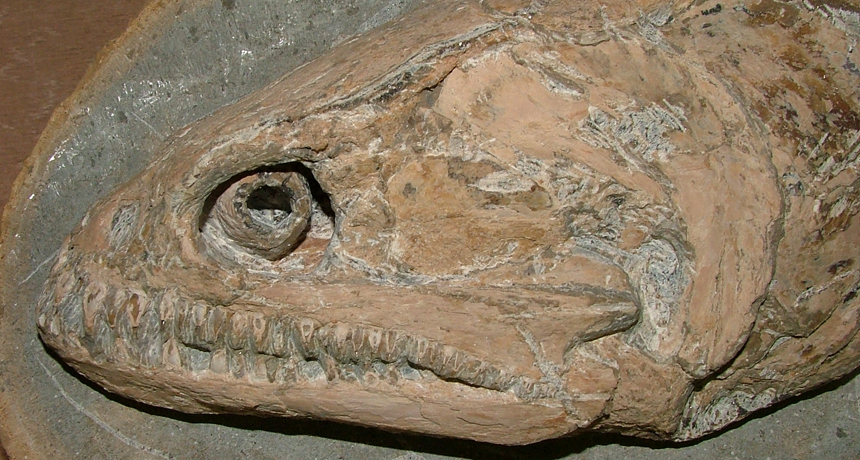
A long-dead fish rears its ugly head. This animal lived 100 million years ago, when dinosaurs still roamed. After it died, it fossilized so quickly that its individual cells were preserved in stone!
David Martill, University of Portsmouth
By Douglas Fox
Deep in the Amazon rainforest of Brazil, a broad, flat tableland rises above the jungle. The earth here is cut by deep muddy gullies, overhung by twisted tree roots. Walk through a gully after a rainstorm and you sometimes find hard lumps of blue-gray rock. Gushing rainwater released them from the gully’s walls. Some rocks are vaguely fish-shaped. It’s as if a fish were wrapped, mummylike, in many layers of cloth, smoothing the form of its body into gentle curves.
Cut through one of the rocks with a power saw and you will see that there really is a fish inside. A petrified fish. It’s the fossil of an animal that swam in what was a large coastal lagoon 100 million years ago. That’s back when dinosaurs still roamed the Earth. The fish’s wispy bones stand out in dark brown against the gray stone.
David Martill was only 21 when he first got his hands on a few of these fish-rocks. A collector who had visited Brazil traded them to Martill for fossils from his home country of England. Martill plopped the rocks into buckets of acid. Slowly, the acid ate away the rock to reveal what lay inside. This process was far gentler than sawing into the rocks would have been. With time, the acid bath revealed something astonishing.
In rock after rock, Martill didn’t just find a skeleton of the fish. He also found its organs petrified in stone. He found the stomach, intestines and the delicate feather-like gills that the fish used to breathe. In the stomach of one fish, Martill even found the petrified remains of its last meal: the bodies of shrimpy creatures called ostracods. And when he looked closely at the fossil gills under a microscope, he realized that even individual cells had been preserved.
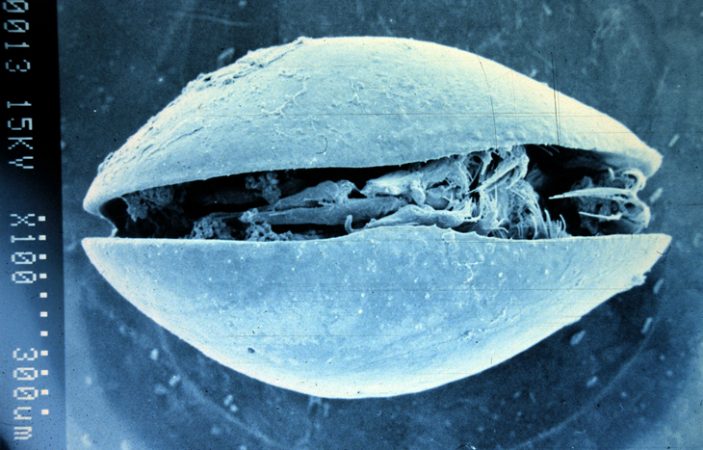
To find out, over the next several years Martill did a bizarre set of experiments. The study of what happens to things after they die is a serious branch of science, called taphonomy (Tuh FAH nuh mee). Martill put smelly bits of dead fish into buckets. Then he watched as they melted into rotten mush. (Today, he still studies fossils as a paleontologist at the University of Portsmouth in England.)
This and similar stinky experiments have allowed Martill and other scientists to discover how the soft, squishy parts of a fish’s body could have turned to stone so quickly. In the last couple of years, taphonomy experiments have begun providing other answers too. These include answers to some hotly debated questions about the evolution of life on Earth. And by understanding how dead animals rot — and why, sometimes, they don’t and turn to stone instead — scientists are getting a better idea of what these animals actually looked like when they lived millions of years ago.
Flash fossilization
As Martill looked at his fish-rocks, he realized the animals must have turned to stone very quickly. If not, their guts and gills would have rotted away and disappeared. Martill refers to this as “the Medusa effect.” He named it for the mythical monster, with snakes for hair, whose gaze could turn people to stone. It seemed these fish actually had turned to stone in the blink of an eye. How that happened was a mystery. But Martill was determined to solve it. That was the purpose of his fish-rotting experiments.
He took gills of freshly caught trout and let them rot in his lab. It “wasn’t very nice” to kill the fish, he admits —“but we ate most of them, anyway. We just wanted the gills.”
Every so often he retrieved a sample of rotting flesh and looked at it under a microscope. He wanted to see how long gill cells would stay intact after a fish died. These results helped him figure out how quickly the ancient fish must have fossilized in order to preserve the delicate gills from decay.
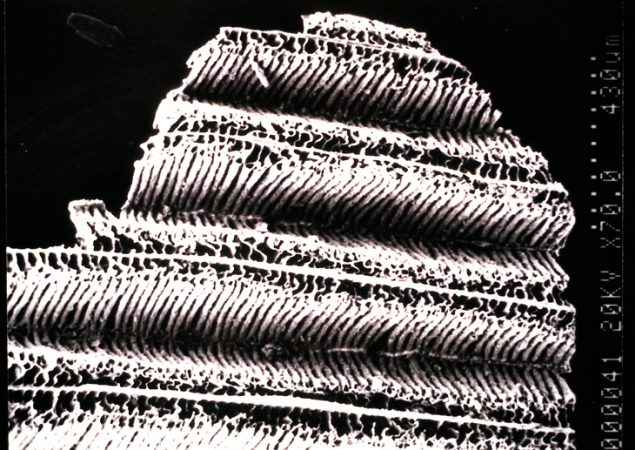
It still wasn’t clear how this would have happened. But in 1992, a friend of Martill’s named Derek Briggs set out to discover the recipe for how to flash petrify an animal. Briggs, now a paleontologist at Yale University in New Haven, Conn., rotted hundreds of tiny dead shrimp in glass beakers. In one trial after another, he altered conditions in the beakers. He wanted to see what conditions led the animals to fossilize quickly.
Most shrimp turned to stinking mush. But now and again, a tiny bit of a shrimp became hardened with minerals. Often, its individual cells were preserved, much as Martill had seen in his fish-rocks.
Briggs discovered that the key ingredient in this hardening was a mineral called calcium phosphate — also known as apatite. Crystals of apatite had grown inside the bodies of Briggs’ shrimp (and long ago, in Martill’s fish) as they fossilized. Those crystals had formed from calcium and phosphate in the water. Those ingredients made all the difference.
Fossils often form when a different mineral, called calcium carbonate, crystallizes within tissue. But carbonate forms big, long and needly crystals inside a dead animal’s body. Those large crystals cannot preserve the tiny details of cells.
“It’s a bit like pixels in a digital image,” explains Briggs. If the pixels — dots that make up a picture — are too large, then a picture will look blocky. It won’t capture fine details. The same is true for the crystals that make up a fossil. The bigger the crystals, the less a fossil will look like an animal. However, with apatite crystals, the situation is different. “Apatite forms very tiny crystallites,” says Briggs. “It means you get a very high resolution image” of the fossilized animal. Sometimes you even can spot single cells!
Helped by bacteria
Briggs’s experiments also revealed another surprise: The same bacteria that were rotting the dead shrimp also helped turn them to fossils.
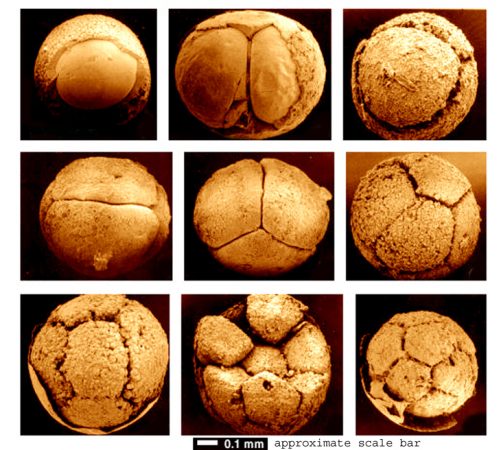
We usually think of decay as erasing an animal’s body from existence. Here, the bacteria did start to eat away at a dead carcass. But they also helped to preserve the shrimp’s tissues, sometimes within hours or days. The microbes did so by generating the conditions that led to the formation of apatite, explains Briggs. That apatite preserved the animal in amazing detail — even its soft, squishy parts that don’t normally fossilize.
Taphonomy experiments by other scientists have revealed more about how bacteria can help preserve a carcass by eating away at it.
At Indiana University in Bloomington, Rudolf and Elizabeth Raff did their first decay experiments in 2005. At the time, the husband-and-wife biologists studied sea creatures called urchins, which look like spikey pincushions. They studied how these animals grew from fertilized eggs into tiny embryos, and from those few cells finally into adults.
That’s when a paleontologist friend called them with an odd question.
He wanted to know if embryos could fossilize. He asked because scientists were digging up thousands of strange fossils in China. Ball-shaped, each fossil was not much wider than a hair. Most contained fewer than 30 cells. Some contained just one or two cells. The fossils were very old, from around 580 million years ago. All looked like tiny embryos — maybe the embryos of some of the first animals on Earth. But biologists were having trouble believing it.
Fossil soap bubble
When asked if they thought that embryos could really fossilize, “We said ‘no,’” Rudolf Raff recalls.
“Preserving an embryo is like preserving a soap bubble,” he says. They are incredibly fragile. If you put a dead embryo in water, “it starts to fall apart within hours.”
Just to be sure, the Raffs did some experiments. They put dead urchin embryos in water and let them rot. Most disintegrated. A few, however, did not.
They used an electron microscope to look closely at these preserved tissues. This kind of microscope let them see not only individual cells, but also tiny structures within them. And it revealed a big surprise.
“The embryo still looks like an embryo,” says Rudolf Raff, “and yet there is no embryo material left. It’s gone.”
In its place, they saw thousands of rod-shaped bacteria stuck together. Each bacterium was far tinier than the embryo — like a brick compared to a house. The microbes had completely eaten up the embryo. But as they grew and multiplied, they built a structure that perfectly matched the shape of the cells that they had eaten. The bacteria had glued themselves together by oozing out a starchy material called polysaccharide.
An embryo replaced with glued-together bacteria is tough. It’s “essentially like turning it into plastic,” he says. “When we keep them at room temperature for up to two years” in the lab, he says, “nothing bad happens to them.” The Raffs call these bacterial structures replicas: The bacteria create a near-perfect replica, or copy, of the embryo that they ate.
Rudolf and Elizabeth Raff now believe that at least some of those Chinese microfossils were indeed petrified embryos. Once bacteria had formed replicas of these ancient embryos, tiny crystals of apatite rapidly grew on them. The crystals encased the bacteria and filled in their empty spaces. That process quickly petrified the replica, preserving the shape and cellular details of the original embryo. Those crystal copies took only a few days to form. But they have lasted half a billion years — about one-ninth of our planet’s history.
The Raffs’ experiments didn’t stop there. They wanted to identify which bacteria might be the flash fossilizers. In July 2013, they reported finding a handful of ocean microbes that can do it. One species “does it perfectly,” says Rudolf Raff. It’s a little bug called Pseudoalteromonas tunicata (SOO-doh-al-ter-oh-MOH-nas TU-ni-KAH-tah). “It’s a species we can grow in the lab,” he says — like “a pet, sort of a trained dog.”
Improving on squished slugs
The study of how dead things rot isn’t just revealing how rare, beautiful fossils form when an animal’s soft parts are preserved. It also is helping scientists better interpret the fossils of animals that haven’t been well preserved. It is even helping them understand what these animals would have looked like when they lived.
Scientists are struggling, for example, to understand how the first vertebrates evolved. Vertebrates are animals with backbones. They include fish, amphibians, reptiles, birds and mammals. Scientists disagree bitterly about how and when vertebrates first appeared. The fossils of early vertebrates and their ancestors are hard to interpret. “They just look like squished slugs,” observes Sarah Gabbott. She’s a paleontologist at the University of Leicester in England.
Gabbott wondered if rotting was part of the problem. People often compare fossils with modern, living animals. This way, they can envision what the fossil animal looked like when it was alive. But animals often decay, at least partially, before they fossilize. And that can complicate things. You can’t just compare a modern animal to a fossil, argues Gabbott. “You have to rot it first.”
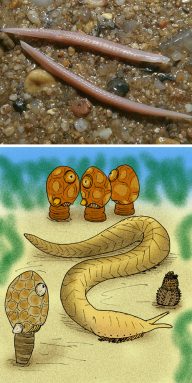
Sansom collected dozens of freshly dead animals. After sealing them inside plastic containers, he let them rot in a laboratory basement. The dead animals included fish called lampreys and hagfish. Both are considered primitive vertebrates. They lack hinged jaws and their skeletons aren’t made of the same hard bones found in most other fish. Instead, they are made of a bendy material called cartilage. Another fishlike species that Sansom rotted, called amphioxus (Am fee OCK sus), is so primitive that it lacks not only bones but also eyes. In place of eyes, it has a single light-sensing organ called an eyespot in the middle of its head.
Sansom rotted these animals for more than a year. Every few days he went down to the basement. After putting on a breathing mask, he popped open the lids of the smelly containers. He dissected the carcasses at each stage of decay to see which body parts were left. Along the way, he snapped many photographs.
“It required a delicate hand,” he notes. The rotting carcasses softened up like pudding. At some point “you’re left with what is effectively soup.” He poured it through a screen to sift out tiny bits that were still left, such as eye lenses and teeth.
What Sansom found surprised him. You might expect the hardest parts of an animal, like cartilage, to stick around longest — and any soft parts, like nerves and muscles, to go first. But Sansom often found just the opposite. “Some cartilage decayed very early,” he says, and “the nerve cord was the last thing left.” (That nerve cord is what would one day evolve into a backbone.) Sansom, Gabbott and their colleague at Leicester, Mark Purnell, published their latest findings in the May 2013 issue of Paleontology.
Their findings can help other scientists interpret the fossil evidence of early vertebrate ancestors. Take, for example, the eel-like animal Cathaymyrus from 500 million years ago. Its fossils don’t have eye spots, tail fins or other body parts seen in even a simple modern animal like amphioxus. This led scientists to speculate that it was far more primitive.
But Sansom’s experiments could change this interpretation.
He found that the body parts missing in Cathaymyrus also happen to be some of the first things to disappear as amphioxus decays. Sansom realized that Cathaymyrus might have actually had many of these body parts — in fact, it might have been far more similar to amphioxus than people assumed. It’s just that the fossilization process didn’t preserve some key evidence.
From these experiments, “we’re able to understand the fossils a lot better,” says Gabbott. Fossils that are interpreted as very primitive might actually represent just the partial remains of organisms that are much more advanced — but badly rotted. Gabbott has realized, in other words, that animals with backbones might have begun evolving earlier than scientists had realized.
A real Medusa
It would be nice if scientists could find less-rotted fossils of Cathaymyrus. But they now understand that to petrify a fish, keeping its soft organs intact requires some special ingredients. It also requires a crucial contribution from many other dead fish that left behind no fossils at all.
The sea floor doesn’t normally contain enough phosphate to fossilize the guts of a fish. Martill suspects that the fossils from Brazil formed when abrupt changes in the saltiness of the lagoon water killed many thousands of fish all at once.
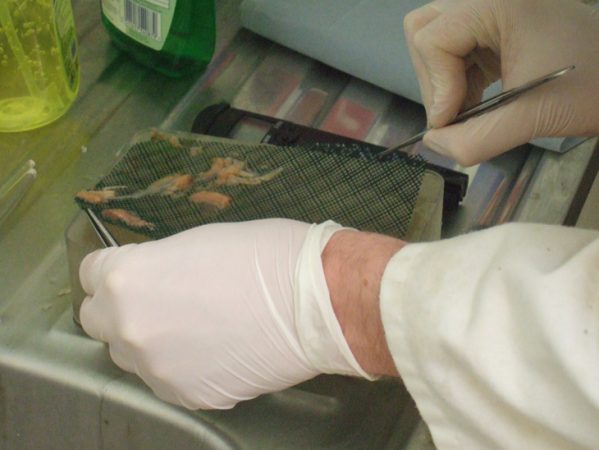
This would have allowed tiny apatite crystals to continue growing inside the bodies of the well-preserved fish that were already buried there.
Other minerals that form by bacterial decay could then cement the mud around the fish, gradually turning it into hard rock. That hard rock acted like a protective casket encasing an Egyptian mummy. It kept the fragile, fossilized remains of these fish from being crushed, even as more mud piled atop them over the years.
One hundred million years later, rains eroded those same lumps of bluish-gray rock from a gully during a rainstorm. Someone found them. And eventually Martill got his hands on a few.
Such well-preserved fossils are rare. For every fish that was preserved with its soft organs intact, many others rotted and disappeared without a trace. Their loss was not in vain: Their bodies likely supplied the precious phosphorus that allowed others to live on, at least as fossils.
Those rare fossils have made a huge difference to scientists studying the past. They also may have given rise to legends. Martill speculates that prehistoric people would have found these amazing fossils of fish and other animals too. They may have wondered what turned the animal to stone. The mystery may have filled them with dread, says Martill. It might even have inspired the legend of the Medusa.
Power Words
amphioxus A simple fish-shaped, water-dwelling animal, also called a lancelet, which does not have true eyes or a brain and lacks a skeleton and a backbone. Amphioxus does have a nerve cord running down its back, and so it is considered to be a primitive evolutionary relative of vertebrates.
apatite A type of mineral, containing calcium and phosphate, which exists in some rocks and some types of fossils, and is a component of bones and the hard white enamel of teeth.
acidic Water containing small amounts of acid, often capable of eating away at some minerals such as carbonate, or preventing their formation in the first place.
bacteria Simple, single-celled organisms that inhabit most environments on Earth.
calcium A chemical element that is common in minerals of the Earth’s crust, and is also found in bone mineral and teeth.
carbonate A group of minerals, including those that make up limestone, which contains carbon and oxygen.
carcass The rotting body of a dead animal.
cartilage The hard, slightly flexible material that is found in the joints of humans and many other vertebrates, and makes up the entire skeleton of sharks, lampreys and some other primitive vertebrates.
cell The smallest, microscopic unit of life. It consists of watery fluid surrounded by a membrane or wall. Animals are made of anywhere from thousands to trillions of cells, depending on their size.
crystal The organized structure taken by most minerals. Apatite, for example, forms six-sided crystals. The mineral crystals that make up rock are usually too small to be seen with the unaided eye.
decay The process (also called “rotting”) by which a dead plant or animal gradually breaks down as it is consumed by bacteria and other microbes.
embryo The early stages of a developing animal, consisting of only one or a few cells.
erode Gradual removal of soil or stone, caused by the flow of water or the movement of winds.
fossil The remains of a previously living plant or animal, often one that died thousands or millions of years ago, preserved in stone. Most fossils of animals include only hard parts such as bones, teeth, and shells. But a few also include remains of soft organs such as the intestine, gills or muscles.
fossilize The process of replacing newly dead tissue with minerals that turn to stone.
gill The organ that filters oxygen out of water, which fish and other water-dwelling animals use to breathe.
hagfish Slimy, eel-shaped fish without hinged jaws, whose skeletons are made of bendy cartilage rather than hard bone. They also have eyes far simpler than those of other fish. Like lampreys, they are considered to be “living fossils” similar to the early relatives of vertebrates that lived hundreds of millions of years ago.
lamprey Eel-like fish without hinged jaws, whose skeletons are made of bendy cartilage rather than hard bone. Like hagfish, they are considered to be “living fossils” similar to the early relatives of vertebrates that lived hundreds of millions of years ago.
Medusa A monster from Greek mythology, also called a Gorgon, with snakes for hair. The Medusa’s gaze could turn people instantly to stone.
microscope A scientific instrument used for looking at things, like bacteria, or the single cells of plants or animals, that are too small to be visible to the unaided eye.
mineral The crystal-forming substances, such as quartz, apatite or various carbonates, that make up rock. Most rocks contain several different minerals mish-mashed together.
muscle The tissue that contracts to produce movement in an animal, such as swimming, walking or chewing.
nerve Long, delicate fibers that communicate across the body of an animal. An animal’s backbone contains many nerves, some of which control the movement of its legs or fins, and some of which convey sensations such as hot, cold and pain.
ostracod A type of water-dwelling crustacean, sometimes called a seed shrimp, usually smaller than the sesame seeds on a hamburger bun.
paleontologist A scientist who studies fossils in order to understand ancient life.
petrified A formerly living thing, such as a tree, shellfish or fish, which has turned to stone through the process of fossilization.
phosphate A chemical containing one atom of phosphorus and four atoms of oxygen, which is a component of bones, hard white tooth enamel and some minerals such as apatite.
pixel (abbreviation for picture element) A single point, or dot that makes up an image on a computer screen, smartphone, or image printed on paper. Photographs are made of thousands of pixels, each of different brightness and color, and each too small to be seen unless the image is magnified.
polysaccharide A type of carbohydrate made from long chains of simpler carbohydrates. Examples of polysaccharides include plant starches and cellulose (a structural material in trees).
taphonomy The study of what happens in plants and animals after they die, including the processes of decay and fossilization.
urchin Small, spine-covered sea animals without eyes or limbs. They are related to sand dollars and starfish.
vertebrate The group of animals with a brain, two eyes and a stiff nerve cord or backbone running down the back. This group includes all fish, amphibians, reptiles, birds and mammals.







